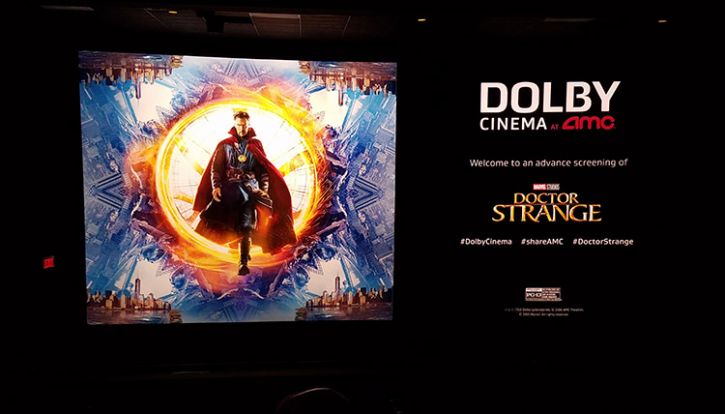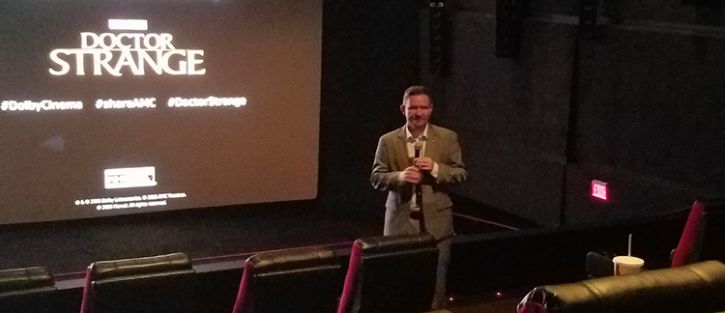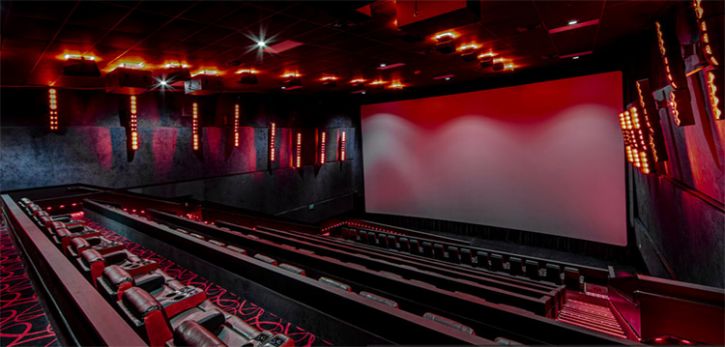When watching movies, we're clearly big fans of big picture and big sound (you might have guessed that). And these days there are no shortage of premium movie-going experiences available to the discriminating viewer. One option that has been embraced by theater chain AMC is Dolby Cinema. Dolby Cinema marries premium visuals - "Dolby Vision" - and premium multidimensional sound - "Dolby Atmos" - into one enhanced audio-visual experience. AMC further enhances that presentation with premium tiered seating: plush chairs with ample space for snacks that recline for maximum viewer comfort. The intended effect is to maximize immersion and enjoyment of the film. And after seeing a screening of "Doctor Strange" in AMC's Dolby Cinema auditorium at their Empire 25 theater in Times Square, I can tell you that it's working. The film's stunning visuals and bombastic sound made for an impressive viewing experience in Dolby Cinema.
Before the film was shown, company reps from both Dolby and AMC took the opportunity to explain just what makes the Dolby technology so impressive, and why AMC is accelerating their plans to deliver the "Dolby Cinema at AMC" experience to more of their customers. According to Cynthia Pierce, SVP, Facilities, Sight & Sound at AMC, the company now plans to build out a total of 160 Dolby Cinema screening rooms across North America by the end of 2018. This is a revision of their earlier plan to deliver 100 Dolby Cinema screens by 2024. And considering they're at 31 screens now, the goal seems pretty ambitious. But according to Pierce, the Dolby Cinema screens have been significantly more successful than they originally projected, which got them thinking about delivering more screens to more people in more places.
According to an AMC representative, Adam Aron, AMC's new CEO, came in to watch "Star Wars: The Force Awakens" in one of the chain's Dolby Cinema auditoriums. After the movie was over, he asked one of his people, "What are our plans for this?" When told the company had announced plans for 100 screens over 10 years, he reportedly said, "We're going to need more than that... and a lot faster." And so the company is doing just that.

So what's so special about Dolby Cinema? At the event, Stewart Bowling, Director, Content and Creative Relations at Dolby explained the benefits of Dolby Cinema. In Dolby Cinema theaters, films are specially encoded using Dolby Vision technology to present the film in High Dynamic Range (HDR). This enhanced image is then projected using special laser projectors which are capable of much better performance and higher light output than traditional film or digital projectors.
Simply put, Dolby Vision's HDR capability offers a greater range between deepest black and brightest white, as well as a greater number of steps between bright and dark areas of the screen. This allows the film-maker to create a version of the film that more closely matches the realism that was captured by the camera in the first place. Black backgrounds are blacker and bright colors are brighter and more vivid. But the system also has the ability to reproduce fine details in the shadows and in bright skies as well. We saw clips from "The Revenant" as well as some custom footage of a talented graffiti artist at work, each of which accentuated the enhanced realism and eye-popping color reproduction of which the Dolby Vision format is capable.

"In regular movie theaters, the projection system is calibrated so that the whitest white on the screen is 14 foot lamberts," said Bowling. "But with Dolby Vision, we can calibrate the screens to support peak whites that are more than twice as bright: 31.5 foot lamberts. This higher peak not only makes the image brighter, but it accentuates the contrast between light and dark areas of the screen, more closely matching what your eyes see in real life."
As for sound, Dolby Atmos allows the film-makers to position sounds very precisely in space, not only all around you, but above you as well, thanks to an array of height speakers installed on the ceiling of the theater. The system is scalable and expandable so it can be used in any size theater or screening room. And because it is an object-based sound format -- not locked into a specific number of channels or speakers -- the system is smart enough to optimize the sound for the exact speaker configuration being used, whether there are just nine speakers in the room or even up to 64 discrete speakers installed throughout the auditorium. You can read more about Dolby Atmos here.

In a Dolby Cinema auditorium, the screen takes up the entire front wall of the theater, for maximum immersion. In the case of the Dolby Cinema at AMC facility in Times Square, that's a 78-foot wide screen -- one of the largest in the chain. The walls are kept a matte black, in order to minimize light reflections that can detract from the audience's ability to focus on the screen. When you combine these advanced technologies and advanced design with comfortable seats, ample space and unobstructed sight lines, Dolby Cinema at AMC gives the audience an immersive and engaging viewing experience which leaves regular theaters in the dust.
Related Stories: